The Rise of the Upconversion Materials
An important class of nanoparticles made of “upconversion” materials has found a central role in sensing. These nanoparticles are used to convert longer-wavelength photons into shorter-wavelength fluorescence to detect temperature, pH, gas molecules, ions, and trace biomolecules.
Over the last few decades, an important class of nanoparticles made of “upconversion” materials has found a central role in sensing. These nanoparticles convert multiple longer-wavelength photons into shorter-wavelength fluorescence. Because they have relatively bright, narrowband fluorescence, they are useful indicators in a variety of situations. Upconversion nanoparticles have been used for detecting temperature, pH, gas molecules, ions, and trace biomolecules. This article discusses their use and some of the most exciting applications of upconversion materials for fluorescent detection.
Fluorescence methods are typically characterized by high specificity and low detection limits, and so, for a spectroscopist, they are quite valuable tools. Some of the difficulties inherent in fluorescence include: 1) finding a transition in the analyte that has a strong enough emission line; 2) finding a light source that is tuned to the excitation transition and that does not interfere with the sample; and 3) detecting the emitted light versus the background. For many molecules and measurement targets of interest, this trifecta of difficulties is hard to satisfy, and direct fluorescence of the target is not possible.
In the 1990s, and even earlier, work started to understand how fluorescent “tags” could be added to targets for which direct fluorescence was not possible. An example of this is the work of Roger Tsien, my former colleague at the University of California, San Diego (UCSD), who helped pioneer the use of green fluorescent protein tags. In practice, a protein of interest is also coded with the gene for a green fluorescent protein. When the protein of interest is expressed, it also has the green fluorescent tag, and, upon irradiation, will show where the protein of interest resides in a cell or organism. In this case, ultraviolet (UV) light is used to irradiate the sample, and the sample emits in the green. A nice feature of this and many fluorescence techniques in biology and other fields is that the fluorescence is in the visible region, which allows the use of standard microscopes and cameras for detection. Tsien shared the Nobel Prize in Chemistry in 2008 with Martin Chalfie and Osamu Shimomura for this work.
This example and several others one could cite of fluorescent tags are examples of “downconversion.” That is, short-wavelength probe light is converted into longer-wavelength detected fluorescence. In general, this is a favored and simple-to-conceive process, both quantum-mechanically and considering potential losses in the process. There are several downsides, however. First, short-wavelength excitation usually means an excitation source in the UV. In the past, UV sources have been hard to obtain (although recently more and more are available), and, due to the high energy, UV light is more likely than longer-wavelength light to induce photochemical reaction, ionization, and thermal heating. Furthermore, UV light generally does not penetrate well into tissues, given the combination of hemoglobin absorption, water absorption, and scattering. These attributes are not ideal.
Upconversion Materials
Conceivably, then, it would be a great advantage to arrange fluorescence the opposite way; that is, to excite the target in the longer-wavelength and measure the emission at the shorter wavelengths. If the emission is to still be in the visible region, this would most likely involve exciting the emission in the near infrared (NIR). NIR excitation allows taking advantage of biological windows, in which tissue absorption (water, blood, other components) are reduced, with correspondingly greater penetration depths for the light into tissue than for other wavelength regions. Such anti-Stokes emission is possible, and a class of upconversion materials, both organic and inorganic, have arisen in the last few decades to facilitate upconversion fluorescence. Here, we focus on upconversion nanoparticles, as well as a little bit of the physics (which is quite involved), and provide some examples of their uses as sensors.
Physical Background
Upconversion nanoparticles are typically sub-100 nanometer particles that have actinide- or lanthanide-doped transition metals in a matrix. The outer 5s and 5p shells protect the non-bonding 4f orbitals, which have many possible excited state energies. These 4f excited state energies will become even more numerous, due to splitting under the crystal field (local effect of charges) when the actinide or lanthanide is embedded in a bulk, such as a crystal, or a nanostructure or a nanoparticle. Because of the shielding from the 5s and 5p orbitals, this near-continuum of 4f state energies is effectively protected, which yields long lifetimes for the excited states.
There has been substantial research into the mechanisms of upconversion, the two most efficient, and thus most important, being mentioned here. The first is classical multiphoton absorption, termed excited state absorption (ESA). In ESA, two or more photons are absorbed simultaneously with the help of an excited state (or multiple excited states) to facilitate the energy absorption. As noted above, a near-continuum of closely spaced excited states are possible in transition metal-doped upconversion materials. A limiting effect of ESA is the necessity of simultaneous multiphoton absorption, which implies high fluence. However, ESA is a key mechanism of upconversion in the presence of a high flux of pump photons.
A second and often more important mechanism was initially researched by François Azul in the mid-1960s during his Ph.D. research which he called APTE (for Addition de Photons par Transfert d’Energie)(1), and now more commonly termed energy transfer upconversion (ETU). In this case, one or more excited sensitizer (S) ions participate in exciting the activator (A) ion of the same type, which subsequently emits a shorter-wave photon. Either the A ion can be excited optically, and undergoes additional energy transfer from an S ion to reach the excited state from which it emits, or the A ion can be excited by two optically-excited S ions. In either case, this results in the emission of shorter-wavelength photons from the longer-wave excitation, or upconversion.
Both ESA and ETU rely on the fact that the transition metals in the nanoparticle have a multitude of excited state energies within bands. This allows selective excitation and results in relatively sharp fluorescence emission from the excited state. A fuller catalog of more of the possible excitation mechanism is shown in Figure 1, including several additional mechanisms that are less efficient than ESA and ETU.
Figure 1: Various upconversion transfer methods and their relative efficiency η in selected upconversion materials. Note that ETU (labeled “APTE effect”) and ESA (labeled “2_steps absorption”) are the dominant effects. Reprinted with permission from reference (3). Copyright 2004 American Chemical Society (1).
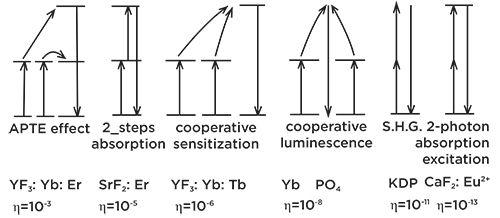
In practice, upconversion nanoparticles are then incorporated into targets. Wolfbeis notes that there are three primary modalities in use for bioimaging (quoting directly [2]):
- In the most simple one, a strong fluorophore or fluorescent nanoparticles are internalized into cells so that they can be imaged. The only purpose of such fluorophores and nanomaterials is to render cells or tissue fluorescent. They do not possess (and are not expected to possess) affinity for a specific site, nor do they respond (like indicator probes) to the presence of chemical species such as certain ions or organic molecules.
- The second technique is referred to as targeted bioimaging. It enables specific domains or species to be detected, very much like immunostaining or fluorescence in situ hybridization. In order to accomplish this, fluorophores or nanoparticles are applied whose surface has been properly functionalized, for example with receptors, ligands, antibodies, or oligomers, so as to recognize the specific counterpart. Examples include targeting of tumor markers, genes, mitochondria, membranes, or the amyloidic plaques in Alzheimer-associated tissue.
- The third technique is making use of probes and nanomaterials with sensing capability. This enables (bio)chemical species to be imaged that are to not intrinsically fluorescent. Examples include imaging of the distribution of chemical species, such as pH values, glucose, calcium(II), or oxygen in the living and metabolizing cell, if not in tumor cells or in cells exposed to candidate drugs. This group also involves nanosensors for temperature.
These three categories (general detection of the nanoparticle, functionalizing the nanoparticle to attach to a specific receptor for detection of the receptor, and detection of properties using upconversion nanoparticles) can be applied outside of only bioimaging to a host of other applications, such as drug release and delivery, temperature sensing, and even as photoswitches, where a thermally-stable upconversion nanoparticle is used to deliver UV light upon NIR excitation, and the UV light activates a chemical change, storing information. Current research in upconversion nanoparticles and their uses include a plethora of varied applications, including optical barcoding, trace chemical identification, and in solar panels to convert longer-wave solar radiation into the bandgap of the solar cell (such as silicon, for example).
Use of Upconversion Nanoparticles in Thermometry
There are many biological and reactive systems in which temperature measurements are crucial. Particularly for biological systems, standard physical measurements (for example, thermocouple and thermistor) are not possible, due to the possibility of perturbing the system, and optical measurements are one of the only possibilities. Existing methods of optical temperature usually rely on intensity measurements of the emission intensity between two states I1 and I2. In some cases, spectral shift or emission rise time or lifetime measurements may be used for temperature, but these are typically much more expensive and difficult measurements than fluorescence intensity.
Measurement of emission intensity relies on the familiar Boltzmann equation, where:
[1]

In equation 1, kB is the Boltzmann constant, and T is the temperature, and both the emission coefficient B and the difference in energy levels ΔE between I2 and I1 are functions of temperature and properties of the media. Because of the media-dependence, typically a new calibration is required for each new medium, and these calibrations rely on a secondary source for the true data.
Balabhadra and associates determined a method to use upconversion nanoparticles as primary thermometers independent of media, using the finding that trivalent lanthanide (Ln3+) ions have thermally-coupled electronic levels, protected as noted above by the valence electrons in the 5-shell (4). This allows them to be used as primary thermometers, not requiring an external calibration source and independent of media. They used SrF2 nanoparticles doped with the Yb/Er ion pair for the measurement. In their process, Yb3+ is the sensitizer and Er3+ is the activator (see above). The ytterbium ion is excited by 980 nm light, and promotes excitation of an upper state of Er3+. After energy transfer in the Er3+, they monitor three bands of emission from Er in the 510 to 570 nm region. Two of the upper-state energy levels are coupled (and thus their relative emission is temperature-invariant), while one is not coupled.
Figure 2 summarizes their results. Denoting the temperature-invariant emission from the coupled energy levels between 510 to 530 nm as I2, and the emission from the uncoupled, temperature-variant energy level between 535 and 555 nm as I1, the authors found that they could accurately measure temperature in any media using this system. In the graph on the right side of Figure 2, they show measurements of the nanoparticle powder alone and measurements of the nanoparticles suspended in water, both compared with the theoretical prediction. The repeatability of the temperature measurement was greater than 99% and the minimum temperature uncertainty was 0.265 K.
Figure 2: Schematic and results from using SrF2:Yb/Er upconverting nanoparticles as a primary temperature probe, reprinted with permission from reference (4). Copyright 2017 American Chemical Society.
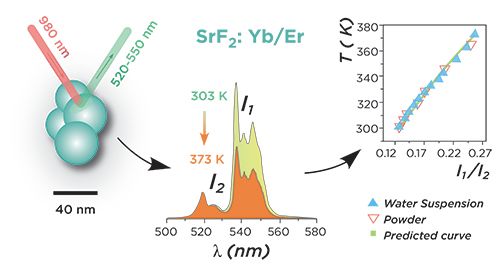
Use of Coated Upconversion Nanoparticles for Photothermal Therapy
Photothermal therapy is used to kill cancer cells, typically raising their temperature to 42-45 °C or higher. Unfortunately, this can also kill healthy surrounding tissue. Zhu and coworkers combined an upconversion nanoparticle with a graphitic coating to form a combined temperature sensor and photothermal heating nanoparticle (5). The upconversion nanoparticle measured temperature using the same scheme as shown in Figure 2, above. Additionally, a 730 nm laser was used to heat the particle, with the upconversion nanoparticle used for feedback control. Figure 3 illustrates the apparent temperature measured by a thermometer and the eigen-temperature measured by the upconversion nanoparticle. Due to the very small size of the nanoparticle, there is a large difference between the microscale eigen-temperature and the apparent temperature measured by the thermometer. The right-hand frame of Figure 3 illustrates the expected scale of heating from the nanoparticle, as measured by finite element modeling of the conduction process.
Figure 3: (a) Measured temperature by bulk thermometry (A.T.) and upconversion nanoparticle thermometry (E.T.) during photothermal therapy under 730 nm radiation. (b) Typical expected heat distribution from the upconversion nanoparticle from finite element analysis. Adapted from reference (5) and shared under Creative Commons Attribution 4.0 International License.
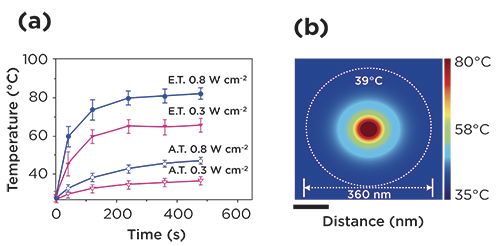
A thermal camera and a fiber-optic spectrometer were used during photothermal therapy on tests with mice with induced tumors. In Figure 4, Layer 1 is the tumor layer, and Layer 2 is the healthy tissue. It was determined that it was possible to heat the tumor enough to kill the cancer, while saving the healthy tissue. The mice were treated for 3 min each day for 5 d, with the rise in apparent temperature of the tumor controlled to 1.5 K. Within that time period, the tumors in the treatment group shrank, and upon further treatment, they were finally eliminated.
Figure 4: Testing the photothermal therapy in mouse tumors, (a) using both the upconversion nanoparticles for absolute temperature measurement and a thermal camera to (b) estimate the temperature throughout the tumor area. Adapted from reference (5) and shared under Creative Commons Attribution 4.0 International License.
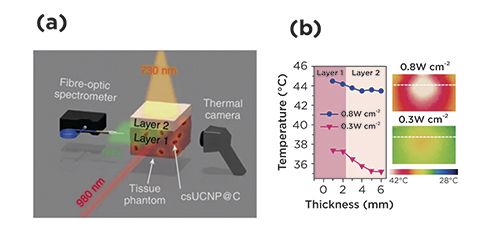
Use of Upconversion Nanoparticles as a Switch for Drug Delivery
One of the interesting problems in medicine involves delivery of biomacromolecules and drugs at the appropriate time and to the right point in the organism for therapeutic response. Polymer hydrogels can be used as a matrix for holding biomacromolecules, keeping them from reacting with other species until a triggering event. The trigger causes a structural change in the hydrogel that allows the trapped biomolecule to release and interact. These and other, similar applications (such as upconversion nanoparticles for memory applications) are considered switching applications, in which the light from the upconversion nanoparticle triggers a process.
UV and visible light can trigger the appropriate structural changes, in particular light-responsive hydrogels, to release biomacromolecules. However, as indicated earlier, UV and visible light are strongly absorbed by tissues, and it is only in the NIR biological windows that light will penetrate very deeply into tissue. Yan and associates showed that upconversion nanoparticles excited with continuous-wave light at 980 nm generated light in the 250 to 400 nm range could induce the appropriate gel-sol transition to break down the polymeric component in a particular photosensitive hydrogel, releasing the bioactive ingredient, in the case, a protein (6). Figure 5 illustrates the emission from the protein when the NIR diode laser was turned on for 5 minute bursts, and then kept off for approximately 15 min, at two different power levels, allowing temporal control of protein release.
Figure 5: Figure illustrating release of protein from an encapsulating sol-gel, activated by ultraviolet (UV) light generated by upconversion nanoparticles under near infrared (NIR) radiation. Reprinted (adapted) with permission from reference (6). Copyright 2012 American Chemical Society.
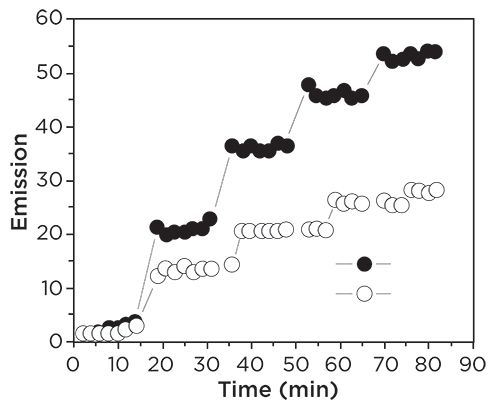
Subsequent work by Jalani and associates has developed new hydrogel materials that cleave more quickly, and also used a LiYF4 upconversion nanoparticle doped with Yb3+ and Tm3+ that not only produced UV bands to cleave the hydrogel bonds, but also produced a strong 790 nm band (7). This emission was used for simultaneous NIR imaging to track the protein or drug particles within the tissue. These applications illustrate the promise of noninvasive in situ drug delivery on demand, initiated by the upconversion photonic process.
Summary
Upconversion nanoparticles have numerous applications in biophotonic imaging, cancer detection, drug delivery, and in physical measurements of temperature, pH, and molecular concentrations. Hopefully this article has provided a taste of the properties of upconversion nanoparticles and has whet your appetite for further study. I predict that these unusual and amazingly useful particles will continue to make headlines for years to come.
References
- F.E. Azul, Proc. IEEE 61(6), 758−786 (1973).
- O.S. Wolfbeis, Chem Soc. Rev. 44, 4743−4768 (2015). Quotation shared under Creative Commons Attribution 3.0 Unported License.
- F.E. Azul, Chem. Rev. 104(1), 139−174 (2004).
- S. Balabhadra et al., J. Phys. Chem. C 121(25), 13962−13968 (2017).
- X. Zhu et al., Nat. Commun. 7, 10437−10446 (2016).
- B. Yan et al., J. Am. Chem. Soc. 134(40), 16558−16561 (2012).
- G. Jalani et al. J. Am. Chem. Soc. 138(3), 1078−1083 (2016).

Steven G. Buckley, PhD, is the Vice President of Product Development and Engineering at Ocean Insight, an affiliate associate professor at the University of Washington, and has started and advised numerous companies in spectroscopy and in applications of machine learning. He has approximately 40 peer-reviewed publications and 6 patents. His work in practical optical spectroscopy, such as LIBS, Raman, and TDL spectroscopy, dovetails with the coverage in this column, which reviews methods (new and old) in laser-based spectroscopy and optical sensing. Direct correspondence to: SpectroscopyEdit@mmhgroup.com.
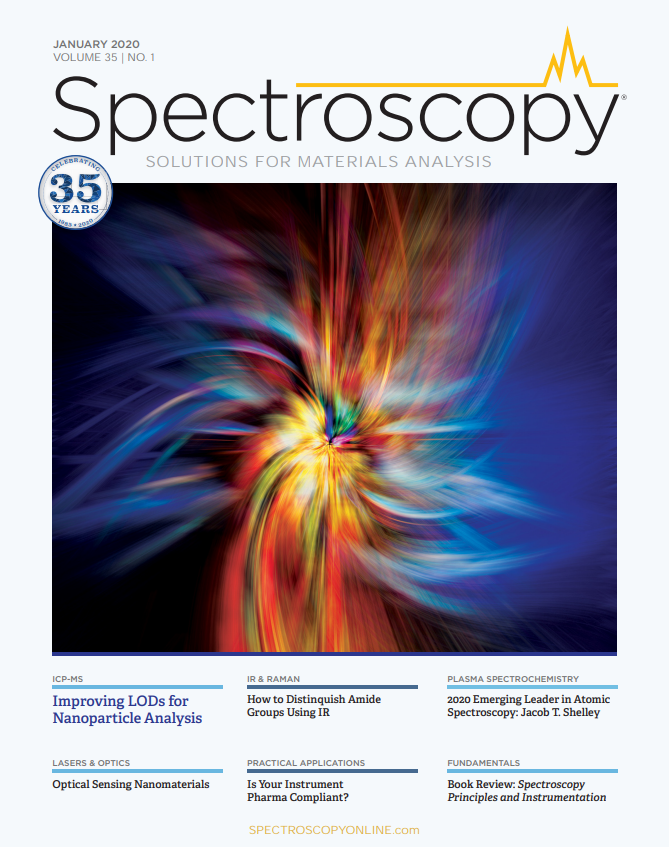
Real-Time Battery Health Tracking Using Fiber-Optic Sensors
April 9th 2025A new study by researchers from Palo Alto Research Center (PARC, a Xerox Company) and LG Chem Power presents a novel method for real-time battery monitoring using embedded fiber-optic sensors. This approach enhances state-of-charge (SOC) and state-of-health (SOH) estimations, potentially improving the efficiency and lifespan of lithium-ion batteries in electric vehicles (xEVs).